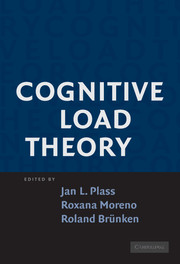Book contents
- Frontmatter
- Contents
- Contributors
- COGNITIVE LOAD THEORY
- Introduction
- PART ONE THEORY
- PART TWO EMPIRICAL EVIDENCE
- PART THREE DISCUSSION
- 9 Measuring Cognitive Load
- 10 From Neo-Behaviorism to Neuroscience: Perspectives on the Origins and Future Contributions of Cognitive Load Research
- 11 Cognitive Load in Learning with Multiple Representations
- 12 Current Issues and Open Questions in Cognitive Load Research
- Index
- References
9 - Measuring Cognitive Load
Published online by Cambridge University Press: 05 June 2012
- Frontmatter
- Contents
- Contributors
- COGNITIVE LOAD THEORY
- Introduction
- PART ONE THEORY
- PART TWO EMPIRICAL EVIDENCE
- PART THREE DISCUSSION
- 9 Measuring Cognitive Load
- 10 From Neo-Behaviorism to Neuroscience: Perspectives on the Origins and Future Contributions of Cognitive Load Research
- 11 Cognitive Load in Learning with Multiple Representations
- 12 Current Issues and Open Questions in Cognitive Load Research
- Index
- References
Summary
THE PROBLEM OF COGNITIVE LOAD MEASUREMENT: WHAT ARE GOOD COGNITIVE LOAD INDICATORS?
The previous chapters have outlined the basic theoretical assumptions for cognitive load theory (Chapter 2), described how cognitive load affects the process of schema acquisition (Chapter 3), and discussed the role that learners' individual differences play in the process of knowledge construction (Chapter 4). The central problem identified by Cognitive Load Theory (CLT) is that learning is impaired when the total amount of processing requirements exceeds the limited capacity of human working memory.
In addition to the fundamental assumption that learning is a function of available cognitive resources, CLT makes some additional assumptions with respect to the relation among cognitive resources, demands, and learning. The first of these additional assumptions is that instructional design and/or methods may induce either a useful (germane) or a wasteful (extraneous) consumption of cognitive capacity. The second assumption is that the source of cognitive load can also vary depending on the complexity of the task to-be-solved (intrinsic cognitive load defined by element interactivity). There is a large body of empirical research supporting the assumptions of CLT by analyzing the relation between the factors influencing cognitive load and learning outcomes. For example, several empirically well-established instructional design principles (Mayer, 2005) were identified in that line of research, which are discussed in other chapters of this book (see Chapters 7, 8). However, can CLT's assumptions be verified directly?
- Type
- Chapter
- Information
- Cognitive Load Theory , pp. 181 - 202Publisher: Cambridge University PressPrint publication year: 2010
References
- 67
- Cited by



